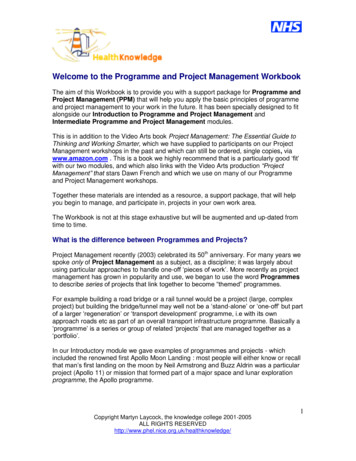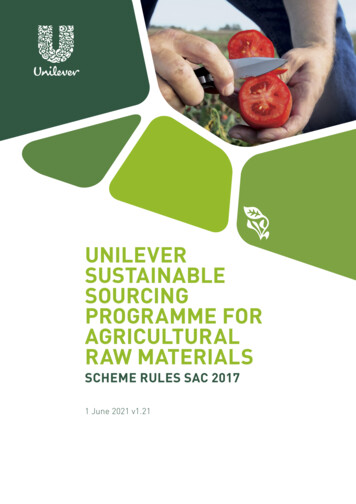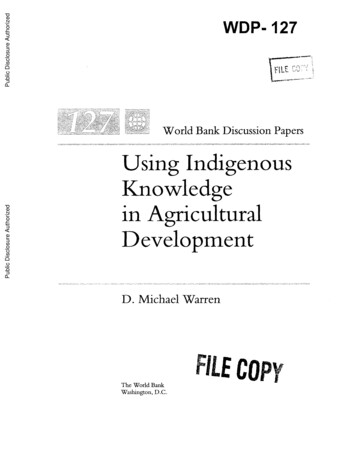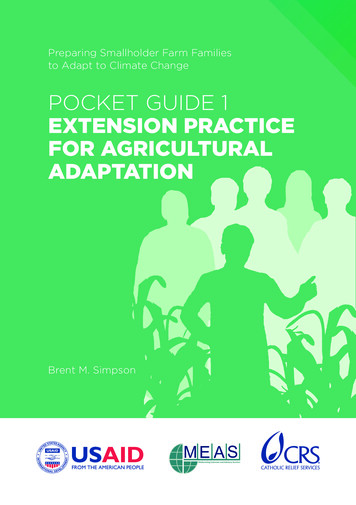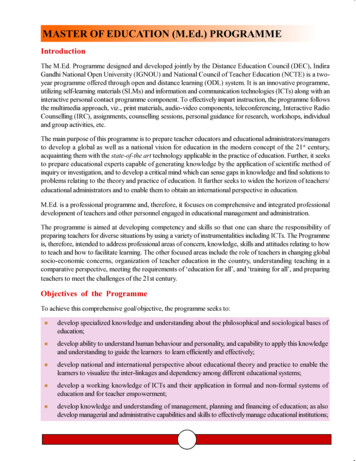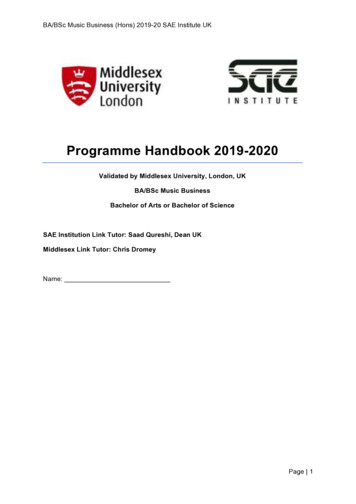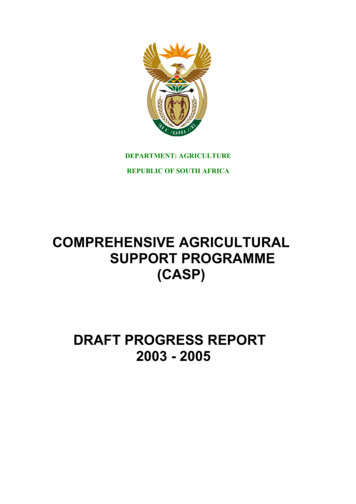
Transcription
DEPARTMENT: AGRICULTUREREPUBLIC OF SOUTH AFRICACOMPREHENSIVE AGRICULTURALSUPPORT PROGRAMME(CASP)DRAFT PROGRESS REPORT2003 - 2005
Abbreviations and Acronyms used in the reportARCAgriculture Research CouncilCASPComprehensive Agricultural Support ProgrammeCFOChief Financial OfficerDORADivision of Revenue ActDMCDepartment Management CommitteeDOADepartment of AgricultureDLADepartment of Land AffairsIFRPIntergovernmental Fiscal Review ProcessITCAIntergovernmental Technical Committee for AgricultureIDPIntegrated Development PlanICTInformation and Communication TechnologyIDTIndependent Development TrustIMPInformation Management PlanLRADLand Redistribution for Agricultural DevelopmentMAFISAMacro Agricultural Finance Scheme of South AfricaMINMECMinisters and Members of Executive CouncilNDANational Development AgencyPMOProject Management OfficePMUProgramme Management UnitPIMSAProject Information Management Systems of AgricultureSITAsState Information Technology Agencies2
Table of ContentsExecutive summary 51. COMPREHENSIVE AGRICULTURE SUPPORT PROGRAMME. 51.1 Description of the programme 51.2 Implementation strategy .61.3 Progress made in implementing the three pronged strategy .71.3.1Prioritization of the on farm and off farm infrastructure 71.3.2Alignment of Support Services .71.3.3The financing strategy 82. CASP ADMINISTRATION ARRANGEMENTS AND BUSINESS PROCESSES .82.1 Programme Management Unit (PMU) & the CASP Secretariat .82.2 The Project Management Office (PMO) .92.3 CASP Information Analysis .92.4 CASP Monitoring Unit .92.5 Gazetting of the grant conditions 92.6 Allocations made to Provinces .102.7 Development of Business Plans .102.8 Approval of business plans 102.9 Compliance Certificate 102.10 Reporting requirements 112.11 Reporting to National Treasury .113. CASP PROGRESS 2003 -2004 .113.1 Launch of CASP .113.2 Expenditure and compliance report for 2004 .123.3 Monitoring of progress by DoA .13-143.4 Provincial Highlights .14-153.5 DoA Highlights .164. CASP RECHARGED – PHASE 2 OF CASP IMPLEMENTATION 2005 .174.1 Key Elements of CASP Recharged .174.1.1 Improve on the delivery systems that are not effective .174.1.2 Improve on the procurement processes .174.1.3 Mobilization of civil society is lacking 174.1.4 The financing criteria is not clear .183
4.1.5 Lack of capacity 184.1.6 Non compliance 185. CASP IMPLEMENTATION - 2005 .195.1 CASP allocation for 2005 195.2 CASP recharged matters addressed 195.3 CASP recharged matters not addressed 205.4 New issues emerging to be incorporated in CASP recharged .216. OUR PLAN FOR 2005/06 226.1 Phasing in of Basic services .226.2 Alignment of support services 226.3 Financial Services 226.4 Strengthen the PMU 226.5 Risk Assessment .234
EXECUTIVE SUMMARYThis is a report on the progress made by the Department of Agriculture and the nineProvinces in implementing the Comprehensive Agriculture Support Programme (CASP)during the 2003/04/05 financial year. The purpose of the report is to provide the user ofthis document with an overview of the progress that has been made as well as theimplementing challenges experienced at different stages. The first part of the documentoutlines the objectives of the programme. It also describes the processes andprocedures as well as the national guideline for project implementation.The second part of the document details the six critical challenges identified andexperienced at the project level during the implementation stage. In addressing thesechallenges, a number of interventions were identified and have now been incorporated inthe framework for the CASP grant condition. The revised plan is now commonly referredto as the CASP supercharged.The third part of the document is an account on the financial resources allocated to eachProvince and the expenditure patterns. The highlights and achievements made duringthe 2003/04 financial year are also captured. An overview of the activities and targets setfor 2004/05 are also captured.The last part of the document outlines the key activities planned for 2005. These includethe launch of pillar 5 the Macro Agriculture and Rural Financing Scheme (MAFISA) andfurther administrative challenges that the PMU has to focus on.Finally, this report reflects the progress that has been made by the IntergovernmentalFiscal Review Committee on agriculture.1. COMPREHENSIVE AGRICULTURE SUPPORT PROGRAMME:1.1 Description of the programmeIn 2003 the Department of Agriculture and nine Provincial Departments of Agriculturesupported by the National Treasury and Provincial Treasury conducted a fiscal review ofthe agricultural sector. The purpose of the review was to identify the cost drivers and thespending pressures within the agricultural sector. Through this Intergovernmental Fiscal5
Review Process, assessment of the agricultural budget and key deliverables wereidentified as well as some of the constraints that hindered service delivery. On furtheranalysis, the IFRP made a key observation - that there was insufficient provision madefor farmer support within the agriculture budget. In addressing this shortfall within thecurrent budget, a number of strategies were identified.This included theComprehensive Agriculture Support Programme (CASP), which was prioritized by thejoint committee for implementation during 2004. To give effect to this decision, thecommittee identified the cost drivers and pressure points currently experienced withinthe budget and to identify outputs to support a framework for a comprehensive supportprogramme. This exercise resulted with the adoption of the Comprehensive AgricultureSupport Programme.In summary, six pillars and four categories of targetedbeneficiaries was identified. The CASP framework is therefore based on the 4x6 modelas shown in (Annexure 1)To further develop the 6x4 CASP model, six joint working groups were established tofocus on the six pillars: On farm and off farm infrastructure; advisory and regulatoryservices; capacity building; information and training, market development; and financialservices. The working groups have for each pillar identified the spending pressures andcost drivers. This information formed the basis for developing the grant conditions andcriteria for supporting the comprehensive agriculture support programme. Once thedepartment had finalized the programme objectives an allocation of R200 million wasmade for implementing CASP within the provisions of the Division of Revenue Act(DORA).1.2 Implementation strategyA three pronged strategy to implement the six pillars of CASP within the four identifiedcategories of beneficiaries was adopted.(i) The first part of the strategy focuses on the alignment of support services related toadvisory and regulatory services; information and training and capacity building. A taskwas established to provide information on the current status and cost drivers.6
(ii) The second strategy was that of phasing in basic support services. These supportservices included On-farm and Off-farm infrastructure, production inputs, marketdevelopment.(iii) The third part of the strategy was the financing services. This is the fifth pillar ofCASP which has resulted in the establishment of the Micro Agriculture FinanceInstitutions of South Africa (MAFISA).1.3 Progress made in implementing the three pronged strategy1.3.1 Prioritization of the on farm and off farm infrastructureAs part of the implementation plan, the intergovernmental meeting prioritized thephasing in of support services. The first pillar for on and off farm infrastructure wasidentified as a critical intervention for effective service delivery. A task team establishednorms and standards and guidelines for the provision of infrastructure related to fencing,dipping, stock handling facilities and water infrastructure. The rationale for prioritizationof infrastructure was due to the fact that this element had not been adequately providedfor within the Provincial budgets to support the Land Redistribution for AgricultureDevelopment (LRAD). The norms and standards for on farm and off farm infrastructureare attached as (Annexure 2).The second group focused on the development of norms and standards for agriculturalmarketing infrastructure (Annexure 3). One of the key standards is that priority would begiven to marketing infrastructure that forms part of the Integrated Development Plan(IDP). Similarly, the project area should demonstrate a high level of agriculturalmarketing and development potential.1.3.2Alignment of Support ServicesThe sub-committees working on the various elements of service delivery that requirealignment have been active during this period. This included the working group that wastasked to align the land and reform agriculture programme (LRAD) with CASP. A reporton the review of the implementation of LRAD is available from the secretariat. As a result7
of this alignment, the representatives of the Department of Land Affairs are now part ofthe National Assessment Panel. Furthermore, the Provincial business plans areendorsed by the regional representatives of the Department of Land Affairs. The secondgroup focused on aligning the food security programme through the introduction ofstarter packs. The group finalized the norms and standards for the starter packs andthese are now being implemented by the various provinces. However, the question offinancing the starter packs has not been achieved. The third group focused on thealignment of training, extension and research. The discussions on the financingagricultural research have been taken up with the Department of Science andTechnology based on the new Governance system for managing the science vote.Further work is still required in aligning the training and capacity building initiatives withinthe Provinces.1.3.3 The financing strategyPillar 5 – the financing mechanism for agricultural support has evolved over the year andresulted in the launch of the Micro Agriculture Finance Institutions of South Africa(MAFISA). The strategic objectives of MAFISA as stipulated in the MAFISA concept noteare human and social assets, productive assets and technology and financial assets andmarkets arises from the fundamental premise of empowering the rural working poor andenterprises in their efforts to better their own lives.These three strategic objectives seek to respectively strengthen the capacity of the ruralworking poor and their organizations; to improve equitable access of the rural workingpoor and enterprises to productive natural resources and technology; and to increaseaccess by the rural working poor and enterprises to financial assets and markets.2. CASP ADMINISTRATION ARRANGEMENTS AND BUSINESS PROCESSES2.1 Programme Management Unit (PMU) & the CASP SecretariatA CASP Programme Management Unit (PMU) was set up. This unit is represented byvarious directorates. The main function of this committee is to coordinate the planning,implementation and monitoring of the programme. The sub-committees include theSecretariat whose function is to ensure that there is proper coordination with the8
Provinces, ensuring that the programme objectives are adhered to and that there iscompliance with the DORA conditions. The Secretariat is responsible for compilingmonthly reports to National Treasury, and quarterly reports on the progress made inimplementing the programme.2.2 The Project Management Office (PMO)The second subcommittee is the project information office. This office ensures that allthe approved projects are captured on a database. The information is collated accordingto the Province, the nodes and the description of the project and its outputs. During thefinancial year 2003/2004 a total of about 164 projects were financed through CASP. Adetailed report is available from the Department.2.3 CASP Information AnalysisAnother subcommittee within the PMU assesses the information needs of the variousdirectorates and the contribution they make towards CASP. This committee held itsmeeting on the 29th May 2005 and it was recommended that workshop should bearranged during August 2005 to review the progress made as well as the challengesencountered in the implementation of CASP2.4 CASP Monitoring UnitThe DoA has set up monitoring teams. These teams are made up of the DepartmentManagement Committee (DMC), a member of the Secretariat and representatives fromthe Farmer Support Unit who are based in the Provinces. There are nine teams,covering each Province. Provincial visits are made twice a year. The role of themonitoring teams is to conduct on site visits and to monitor progress being made at theimplementation level. The terms of reference of the national monitoring teams areavailable from the Department.2.5 Gazetting of the grant conditionsOne of the other key functions of the PMU is to refine the grant conditions framework.The CASP grant conditions were gazetted and grant allocation criteria to Provinces wasbased on a number of variables including the capacity of the province to perform and theinfrastructure backlog. The grant condition as gazetted is attached as (Annexure 4)9
2.6 Allocations made to ProvincesHaving ascertained that all the provisions made for within the Division of Revenue Actwere compiled with, the transfers and allocations were made to Provinces: Eastern CapeR38 million, KwaZulu Natal R37 million, Free State R16 million, Limpopo R33 million,Northern Cape R10 million, Western Cape R13 million, Mpumalanga R18 million,Gauteng R4 million, and North West R26 million. See (Annexure 5)2.7 Development of Business PlansEach Province has appointed a CASP coordinator, whose role is to ensure that there isalignment between the policy directives from DoA and the identification of projects at theProvincial level. The coordinators also ensure that DORA grant conditions are adheredto. Business plan format see (Annexure 6)2.8 Approval of business plansBased on the grant conditions framework and the allocation made to each Province, theProvinces submit business plans to DoA to be evaluated by the National AssessmentCommittee. This committee has representatives from the Department of Land Affairsand Agriculture as well as the Lands Claim Commission. The purpose of this committeeis to ensure that the projects submitted by the Provinces are in line with the grantcondition. This committee makes its recommendations to the Minister for approval. Seecopy of the submission to Minister (Annexure 7)2.9 Compliance CertificateFollowing the NAP approval process, an overall CASP business plan with specificbudget allocations for each province is submitted to the minister for approval. Included inthe business plan is the funding agreement signed by the senior management of eachprovince. Once the minister has signed, the National Treasury is informed of theprovincial budget allocations and certificate of compliance approved by the Departmentof Agriculture. The funding agreement and compliance certificate is attached (annexure8). The compliance certificate is prepared and signed by the transferring national officerof the Department of Agriculture. The compliance certificate is prepared in terms ofSection 20(1) of the Division of Revenue Act, 2005. The budget allocations for2005/2006 to be transferred on quarterly basis according to disbursement schedule asattached in (Annexure 9).10
2.10 DORA ComplianceThe provincial Departments of Agriculture (PDA) are required to prepare projectbusiness plans with specific and measurable targets for implementation. Upon approvalof the business plan, the provinces prepare implementation plans with clear activities tobe undertaken over the project cycle. After receiving the business plans, the CASPsecretariat prepares the grant framework for gazetting by National Treasury. The grantframework captures targeted activities collated from all provinces e.g. number ofboreholes, number of beneficiaries etc. The provinces are expected to report outputsagainst the targeted activities within the stipulated timeframes. The reporting forms areattached as (Annexure 10)2.11 Reporting to National TreasuryThe Comprehensive Agricultural Support Programme (CASP) is required to reportfinancial expenditure and non-financial activities as a compliance with the Division ofRevenue Act (DORA) on monthly and quarterly basis. The Provincial Departments ofAgriculture are implementing CASP on behalf of the National Department of Agriculture(DoA). The provinces are therefore required on monthly basis to submit financialexpenditure reports to the CASP/Landcare Secretariat. These reports are received fromprovinces on the 15th day of each month and collated by the secretariat. After collatingall the reports, the secretariat then sends them to National Treasury via the DoA’sFinancial Management Directorate on the 20th of every month. The verification andconsolidation of reports by the secretariat is done between the 15th and the 20th of eachmonth in liaison with provincial CASP coordinators who compile the reports from aprovincial level. The provincial CASP coordinators are responsible for all implementationCASP issues, including the submission of reports to their CFO’s.The non-financial quarterly reports from provinces are also received at the end of thequarter, collated and send to National Treasury as above. It is required that all reportsfrom provinces are sent by and/or via the Chief Financial Officer (CFO).3. CASP PROGRESS 2003 -20043.1 Launch of CASPCASP was launched on the 17th August 2004 in KwaZulu Natal. At the launch theMinister for Agriculture and Land Affairs announced that the beneficiaries of the land and11
agrarian reform programmes will receive support within the six priority areas and that theintervention will target firstly land reform beneficiaries within the poverty nodes andwithin the agricultural development zones. She further stressed that the successfuldelivery chain depended on the alignment of policies, strategies and processes ensuringthat there are no silo formations, duplication of actions and lack of ownership.3.2 Expenditure and compliance report for 2004The first year (2004/2005) of CASP implementation was not a very good picture foreffective management and DORA compliance by provinces. Provinces had to roll-overlarge sums of money indicating late implementation and lack of planning as a mainreason for poor expenditure performance.Figure 1 and Table 1 below depicts collated provincial expenditure for the quarter andyear ending 2004/2005Figure.1 CASP ProvincialExpenditure ncesTotal 1.6FState16.818.3ECape010203830Total Expenditure (Rmillion)1240
Table 1 Expenditure performance for 2004/2005PROVINCEECapeFree StateGautengKZNLimpopoMpumalangaNCapeNorth WestWestern 6,8704,58237,01633,42818,90310,51826,87613,764% mber ofreports over 10months period)10881098108103.3 Monitoring of progress by DoAThe DoA monitoring teams visited all the nine Provinces in 2004/2005 to assessprogress that had been made, verify the business plans that had been submitted and toidentify any constraints and challenges experienced by Provinces and project recipients.A detailed report on the first Provincial visits is available from the Department website. Insummary, the monitoring group observed that although progress had been made by theProvinces in identifying priority projects, there were however challenges. Siximplementation challenges were identified. These are:(i)The delivery systems for CASP at the Provincial levels are not effective. Itwas noted that time lag from the programme design to the launch had not beensufficient. This new programme was introduced in June and there was nosufficient time to internalize the grant conditions, finalize the norms andstandards and to design an effective delivery system within this given time.Planning started late and there was also poor communication between theProvincial Departments and Provincial Treasury who had received the money.Poor planning resulting in a mismatch between the business plan and the actualprogress on the ground(ii)Procurement and tender system cumbersome. Further observations weremade by some Provinces that the tender and procurement systems werecumbersome and delays were inevitable. The tender committees were not in13
place and in some instances the tender specs were not followed by the projectproponents.(iii)The mobilization of civil society is lacking. As this was a new programme,the awareness campaign on CASP had not taken off. It was not clear who thetargeted beneficiaries were. It was also not clear whether the identified projectswould be based on the LRAD database and how other recipients of otherprogrammes would be priorities. In some instances, where projects haddisintegrated and discontinued, the additional allocation revived interestsamongst beneficiaries and this caused internal conflict.(iv)The financing criteria is not clearThe first phase of CASP was limited to On -farm and Off -farm infrastructureonly, and yet the needs of the beneficiaries were more extensive than expected.It was also not clear whether the grant should be extended tobeneficiaries of other Government programmes and to rehabilitate failedinitiatives. The issue of double dipping in some projects suggested thatinterdepartmental coordination is the key in addressing the diverse projectneeds.(v)Lack of capacityThere are weak monitoring and evaluation systems at the project level as well atthe Provincial level. The lack of engineers and economists to plan and design theprogrammes was identified as a critical constraint. There were few experts in thefield as more of the extension officers are generalists.(vi)Non compliance to the grant conditions.Both monthly and quarterly reports were not being submitted regularly. It alsoemerged that the money allocated was not being spent as allocated anddisbursed to provinces. There has been poor reporting, due to lack ofunderstanding of the reporting format by provinces. The other provincesindicated procurement processes and capacity as the main challenges.3.4 Provincial HighlightsThe preliminary results indicate that progress has been made in implementing theprogramme and that the recommendations outlined in the CASP recharged were alreadybeing implemented by some Provinces. However, there are some Provinces that will rollover the funds to this new financial year. In such instances, it is anticipated that most of14
the projects will be finalized during the year. However, some progress has been made.The highlights include an LRAD beneficiary who is a co-owner of the Thaba Bosiu dairyfarm in the Magaliesberg area. The farm has eleven dairy cows and produces 120 litresof milk a day in summer. From the profits of the sale of milk, the dairy has brought amilking machine and a trailer. The farm bought two Nguni heifers and three ewes. Eachewe lambs two lambs and the number increased up to nine sheep. The farm employstwo full time employees. This case study is an example of how the CASP interventionhas made a difference in the lives of the many beneficiaries. Further interventionsrelated to training and capacity building have also been identified.The Mosely project which is an LRAD farm situated in Barbeton, with 41 beneficiaries isalso an example of the progress made in the implementation of CASP. The farm is 68hectares in size. A big half a hectare (0.5 ha) green house has been built throughsupport from CASP program. The farm has no water rights but still negotiating with theDepartment of Water Affairs. There are 3 boreholes operating in the farm from theprevious owner. There is discussion with the local irrigation board for 3 Ha of waterrights and 3 boreholes shall be utilized for fertigation. Through CASP the project haserected the green house, renovated and repaired the fertigation infrastructure.Regarding markets: Pieter Bucker a supplier of Woolworths has approached the Moselybeneficiaries to assist on the contract. Beneficiaries need insurance for infrastructure.15
3.5 DoA highlightsThe following achievements have been made by the DoA programmes. These includethe verification and validation of the project data base by the Directorate: ProgrammePlanning, for the purpose of populating the Project Information Management Systems forAgriculture (PIMSA). In populating the information, the Directorate is looking at allprojects that are funded by the DoA. To achieve this, the Project Office developed astandard template to be populated by all provinces, since different provinces are usingdifferent templates. The template is composed of the following variable: project number,project name, project size, production activities, target yield, type and number ofbeneficiaries, land ownership, contact details for project leaders, nodal point, districtmunicipality, local municipality, actual location, source of funding, project cost, projectduration and the date the business plan was approved. The compilation of theinformation was done in close liaison with other the department in particularCASP/Landcare secretariat and AGIS. Norms and standards and guidelines for theprovision of infrastructure related to fencing, dipping, stock handling facilities and waterinfrastructure have been developed and incorporated into CASP. The Micro AgricultureFinance Institutions of South Africa (MAFISA) which is the fifth pillar of CASP was16
officially launched in May 2005. The norms and standards for agricultural marketinginfrastructure have also been developed by the Directorate: Marketing.4. CASP RECHARGED – PHASE 2 OF CASP IMPLEMENTATION 2005This report on the general observations made by the national monitoring team wasdiscussed at the Intergovernmental Technical Committee on Agriculture (ITCA) and theLands Claim Commission and by the Department Management Committee (DMC) inNovember 2004. A set of recommendations were made to improve service delivery onthe ground. The review would include the DORA grant conditions framework, thebusiness processes related to the identification of projects and development of businessplans and time frames for reporting and approval of projects.During this year theplanning process was improved greatly and the verification of business plans wasfinalized in December 2004. These recommendations were approved by MinMec inFebruary 2005. The revision of the CASP grant conditions and the revised version isnow popularly known as the CASP recharged.4.1 Key Elements of CASP Recharged4.1.1 Improve on the delivery systems that are not effectiveThe following will be done: Departments to appoint CASP managers and focal points both at the districtsand regional level Ensure that the supporting personnel understands the objectives of theprogramme Assistance in development of business plans Alignment of business plan with ground operations Project planninga. Clear criteriab. Increase capacityc. Reschedule payments based on outputs in business plans Approval procedures clarifiedCommunicationa. Sharing best practices17
4.1.2 Improve on the procurement processes Review current project approach system. Procurement & tender process oUse existing committees (e.g. public works standing committee)oGazette tariffsoReview costsoWeekly tender committeesReview dispensing mechanisms and allocations made to Provinces4.1.3 Mobilization of civil society is lacking¾ Buy in and role clarity amongst beneficiaries. Identify the list of beneficiaries focusingon the land and agrarian reform beneficiaries in the rural nodes and agriculturaldevelopment zones¾ Adopt participatory approaches that focus on needs analysis rather than relying onconsultant reports¾ All Provinces to conduct civil society mobilization initiatives and create generalawareness around CASP and a commitment from the beneficiaries to maintain theinfrastructure.¾ Link to municipalities through IDP to ensure ownership¾ Capacity, farmer organizations Work with the NDA, IDT Mobilize civil society4.1.4 The financing criteria is not clear¾ Focus on all CASP pillars rather than infrastructure only¾ Phase in all the other five pillars of CASP and resources to augment existing budgets¾ Multiple funding approach streamline projects where provinces supplement andcomplement CASP funds¾ Thematic vs. project approach Package CASP into themes like mechanization, capacity building etc KwaZulu Natal uses this thematic approach (e.g. Siyavuna)18
4.1.5 Lack of capacity Develop indicators and project outputs within the intergovernmental fiscalreview process Strengthen communication lines and report quarterly to ITCA DoA team to conduct quarterly visits to the Provinces Monitoring, evaluation & institutionalization Appoint CASP champions Internal audit to play a more significant role Review role of agencies (e.g. ARC, Land Bank)4.1.6 Non compliance Discuss reporting format with National Treasury Identify
2. CASP ADMINISTRATION ARRANGEMENTS AND BUSINESS PROCESSES 2.1 Programme Management Unit (PMU) & the CASP Secretariat A CASP Programme Management Unit (PMU) was set up. This unit is represented by various directorates. The main function of this committee is to coordinate the
